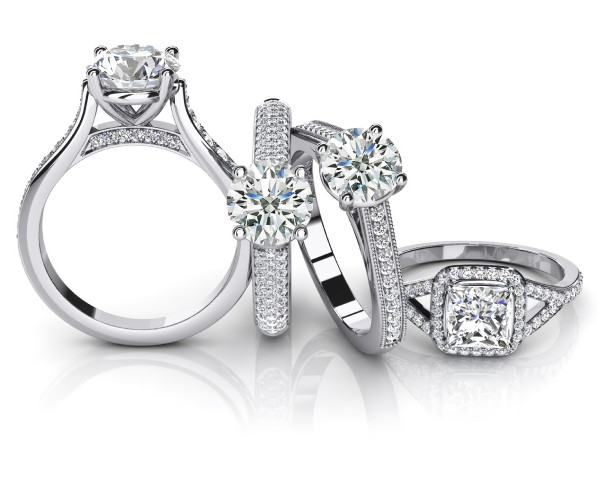Princess. Marquise. Round brilliant. Cushion.
It’s no mystery that diamonds come in a variety of shapes and sizes. The question is, which one is right for your budget?
True love doesn’t come with a price tag, of course, but a romantic proposal doesn’t necessarily have to break the bank. With young workers today earning 5.5 percent less (after adjusting for inflation) than they did four decades ago, according to U.S. Census data, the adage of spending two months’ salary on an engagement ring may not be an option for everyone. Couples are finding new ways to save money on rings, whether by careful stone selection or doing away with a diamond altogether.
“Millennials are making getting engaged all their own,” says Brooke Brinkman, VP of marketing and communications at Simon G. Jewelry, a luxury jewelry brand that specializes in engagement and wedding rings. “While traditional engagement rings still make an appearance, new trends are on the rise.”
Before popping the question, here’s an expert take on how you could save money on the ring of all rings.
1. Size Down and Shape Up
Round brilliant cut diamonds are the most popular stone for engagement rings, and even on a budget, they’re still an option. Diamonds, like other gemstones, are measured in carats, and their price generally rises with their size. So you could cut costs by purchasing a slightly smaller diamond—and in some cases, the difference will be imperceptible. “A 0.9-carat diamond will look very similar to a 1-carat once it’s in the setting,” says Mehul Sompura, CEO and founder of Diamond Hedge, a diamond price-comparison company. “To the naked eye, you can’t really tell the difference in size once set. But there’s a large jump in price when you get to the whole numbers.”
Another trick? Change the shape. Since round brilliant cut diamonds are the most sought after, they tend to be the costlier choice. A shape like princess or oval could help lower the cost and help keep the carat size in your ideal range. “Oval diamonds appear larger because they carry most of their weight on the surface and elongate the finger,” says Brinkman.
2. Take a Small Step Down in Color and Clarity
Carats measure weight, but diamonds have other scales too. Color is graded from D (colorless) to Z (faintly yellow). Clarity is noted by a range of abbreviations that include FL (“flawless”) and SI (“slightly included,” i.e., having internal markings not visible to the naked eye). The difference in both will again be difficult to see, and the savings could be substantial, says Brinkman.
“The best value can be found by choosing a stone that is G or H in color and SI in clarity,” she says. This will give you a stone that looks great “and helps you avoid paying for things your eye won’t be able to discern.”
3. Buy More Diamonds
It sounds counterintuitive, but a ring with multiple small stones can be a cheaper option than one with a single large gem. A popular choice right now is a mosaic setting, Sompura says, which consists of “tiny diamonds in an oval or heart shape, positioned so close together that it looks like that shape.” Another favored setting using multiple stones is the halo. By surrounding a center stone with smaller stones, the design gives the head of the ring a greater surface area and therefore a larger appearance.
4. Skip Diamonds Altogether
Diamonds haven’t always been popular: Before World War II, a vast majority of proposals didn’t involve diamond engagement rings. By the 1990s, however, it was hard to find a bride without one. Today, new trends like colored stones compete with the classic diamond ring more than ever before. Stones like sapphires, rubies and emeralds are just as beautiful and can be unique, says Sompura. He’s seen many couples choose an alternative center stone with diamonds set around it or on the band, or rings that have no diamonds at all.
5. Know Your Metals
Just like the stone itself, the metal you choose influences the cost of the ring. “The biggest price difference is between platinum and gold,” says Sompura. “Platinum is stronger and more durable than gold, so if you want stronger prongs, then you should go with platinum,” he says.
Beyond color and appearance, shoppers should consider the longevity, upkeep and level of scratch-resistance before settling on a metal. Of course, just as the classic 18-karat white gold will run up the price, a band made of titanium (which is usually a darker shade of silver) could result in some savings, says Sompura.
Diamond Hedge is the first augmented reality diamond price comparison company where people can shop and compare from over 1 million diamonds from all the leading diamond companies.
Subscribe for free to receive new blog posts.
